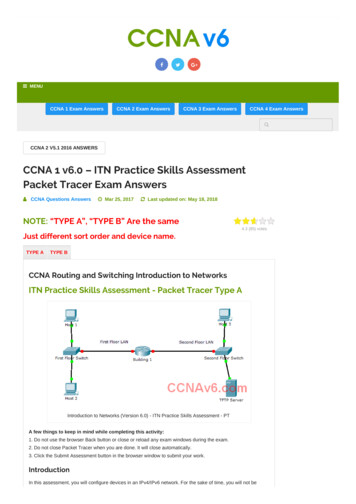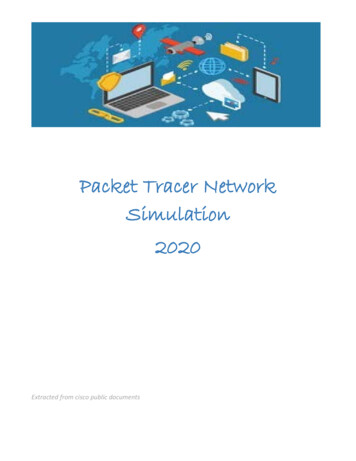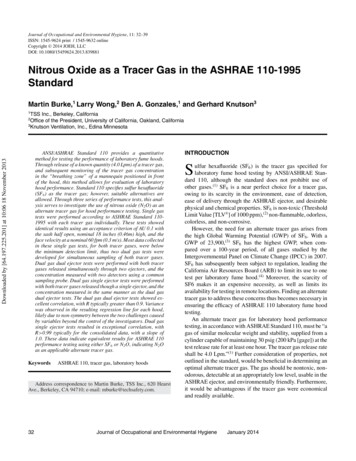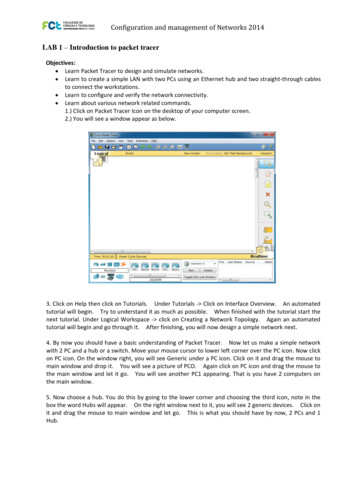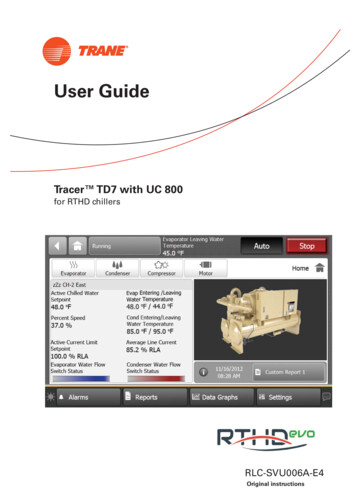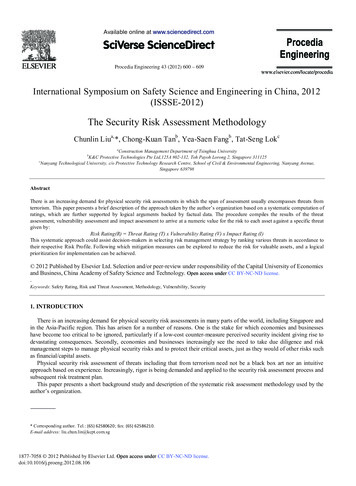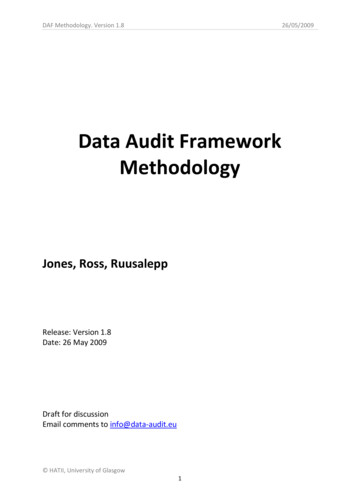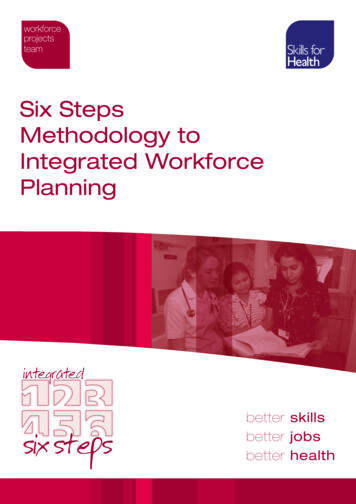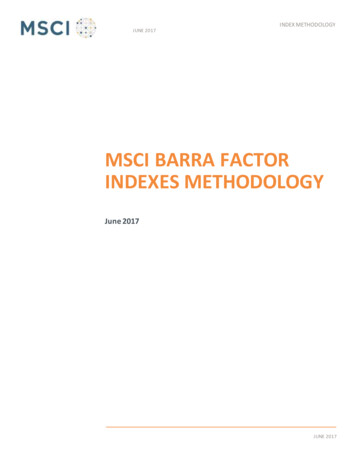
Transcription
Unannounced SurveyUnannounced Survey:Frontline Strategies to PrepareYour Organization for Surprise Surveysby Missi Halvorsen, RN, BSNMeet the AuthorMs. Halvorsen has been a nurse for over 18 years, with experience in critical care, home care, quality,and performance improvement, and has been actively involved in JCAHO prep since 1998.Additionally, Baptist Health Center, one of her facilities, earned the JCAHO’s esteemed Ernest A.Codman Award for hospitals in 2003 in recognition for an initiative that reduced the infectionrates of post-operative, coronary artery bypass graft surgery patients.About HCPro, Inc.HCPro, Inc., is the premier publisher of information and training resources for the healthcare community. Our line of products includes newsletters, books, audioconferences, training handbooks, videos,online learning courses, and professional consulting seminars for specialists in health informationmanagement, compliance, accreditation, quality and patient safety, nursing, pharmaceuticals, medicalstaff, credentialing, long-term care, physician practice, infection control, and safety.Visit the Healthcare Marketplace at www.hcmarketplace.com for information on any of our products,or to sign up for one or more of our free online e-zines.HCPro200 Hoods LaneMarblehead, MA 01945www.hcmarketplace.comHalvorsenUSFSFrontline Strategies to Prepare Your Organization for Surprise SurveysMissi Halvorsen, RN, BSN, author of the best-selling HCPro publication Tracer Methodology, is thesenior consultant for accreditation for Baptist Health, a five-hospital health care system that servicesthe needs of a five-county region in northeast Florida. Her responsibilities include JCAHO prep foradult and pediatric inpatient, outpatient, ambulatory, behavioral health, and home care services. Shechairs the Systemwide Accreditation Committee, dedicated to continuous survey readiness, and sits onPatient Safety and Environment of Care committees. She is also a member of local and state QualityImprovement Chapters.Unannounced SurveyFrontline Strategies toPrepare Your Organizationfor Surprise SurveysMissi Halvorsen, RN, BSN
C ontentsAboutthe author . . . . . . . . . . . . . . . . . . . . . . . . . . . . . . . . . . . . . . . . . . vAcknowledgements . . . . . . . . . . . . . . . . . . . . . . . . . . . . . . . . . . . . . . . . .viIntroduction . . . . . . . . . . . . . . . . . . . . . . . . . . . . . . . . . . . . . . . . . . . . . viiSection one: Types of unannounced surveys . .JCAHO . . . . . . . . . . . . . . . . . . . . . . . . . . . . . . .Regular JCAHO surveys . . . . . . . . . . . . . . . .Special JCAHO unannounced surveys . . . . . .Regulatory unannounced surveys . . . . . . . . . . . .Occurrence investigations/Code 15s . . . . . . .State survey of employee/patient complaints .Medicare validation survey . . . . . . . . . . . . . .Medicare licensure survey . . . . . . . . . . . . . . . . . . . . . . . . . . . . . . . . . . . . . . . . . . . . . . . . . . . . . . . . . . . . . . . . . . . . . . . . . . . . . . . . . . . . . . . . . . . . . . . . . . . . . . . . . . . . . . . . . . . . . . . . . . . . . . . . . . . . . . . . . . . . . . . . . . . . . . . . . . . . . . . . . . . . . . . . . . . . . . . . . . . . . . . . . . . 1. . . . . . . . . 3. . . . . . . . . 3. . . . . . . . 10. . . . . . . . 19. . . . . . . . 19. . . . . . . . 21. . . . . . . . 23. . . . . . . . 30Section two: Preparing for unannounced surveys . . . . .Develop an infrastructure for continuous readiness . . . . . . . .Command central . . . . . . . . . . . . . . . . . . . . . . . . . . . . . . . .Presenting to surveyors . . . . . . . . . . . . . . . . . . . . . . . . . . . .A plan for unannounced surveys . . . . . . . . . . . . . . . . . . . . . . . . . . . . . . . . . . . . . . . . . . . . . . . . . . . . . . . . . . . . . . . . . . . . . . . . . . . . . . 43. . . . . . . . 45. . . . . . . . 47. . . . . . . . 88. . . . . . . 101Section three: Avoiding special unannounced surveys . . . . . . . . . . . . . . . . . . 107Overview of APR 17 . . . . . . . . . . . . . . . . . . . . . . . . . . . . . . . . . . . . . . . . . . . . . . . . . . . 110Unannounced Survey: Frontline StrategiestoPrepare Your OrganizationforSurprise Surveys
ContentsSectionfour :Conclusion . . . . . . . . . . . . . . . . . . . . . . . . . . . . . . . . . . . . 111Appendix A: Sample survey questions . . .CMS Validation survey . . . . . . . . . . . . . . . .CMS Licensure survey . . . . . . . . . . . . . . . .JCAHO system tracers . . . . . . . . . . . . . . . .Appendix B: Sample . . . . . . . . . . . .survey prep pocket guide . .Unannounced Survey: Frontline Strategies. . . . . . . . . . . . . . . . . . . . . . . . . . . . . . . . . . . . . . . . . . . . . . . . . . . . . . . . . . . . . . . . . . . . . . . . . . . . . . . . . . . . . . . . . . . . . .115117128139. . . . . . . . . . . . . . . . . . . . . . 149toPrepare Your OrganizationforSurprise Surveys
SectiononeTypes ofunannounced surveys
SectiononeT ypesof unannounced surveysJCAHORegular JCAHO surveys (unannounced as of January 2006)Spurred by criticism from the media, the public, and the Centers for Medicare & Medicaid Services(CMS) for its so-called “lenient” survey process, the Joint Commission on Accreditation of HealthcareOrganizations (JCAHO) overhauled its entire accreditation process in 2004. This overhaul includedchanges in the standards, scoring, and methods used to survey (i.e., tracer methodology), new agendaformats for all accredited organizations, and the introduction of unannounced surveys.The JCAHO offered unannounced triennial surveys as an option for organizations in 2004, and 36healthcare organizations volunteered to pilot the unannounced survey process. In 2005, the numberof volunteers for the unannounced survey more than doubled to 86 healthcare organizations, a smallpercentage of the total number of accredited healthcare organizations. In spite of the poor organizational response to the option offered, the wheels were already well oiled to move all triennial surveys tounannounced by 2006.So, how will these unannounced regular surveys work? We know some things about unannouncedtriennial surveys, and some things the JCAHO has yet to explain.We know that the survey application must be updated on an annual basis. It provides ongoingdemographic and clinical service group information, and the JCAHO uses this information to determinethe number and type of surveyors needed to survey your organization. Because the application processtraditionally triggered the triennial survey, an annual update will provide no clue to your survey date.Unannounced Survey: Frontline StrategiestoPrepare Your OrganizationforSurprise Surveys
SectiononeWe also know the survey fees will be spread over the three-year cycle. An agreement must be signedbetween the JCAHO and your organization to begin this process. If you have not already signed thisagreement, speak with your account representative for more information.Because the survey is unannounced, we know that the public information interview opportunity process will change. With announced surveys, healthcare organizations are required to provide 30days’ notice to the public regarding the survey date. To provide such notice, they must post noticesat entrances and exits and in the local newspaper or radio station. Public notice gives the communityand advocacy groups an opportunity to discuss quality or patient safety concerns with the JCAHO.With an unannounced survey process, however, the healthcare organization will be required to demonstrate how it regularly provides information to the public regarding how to notify the JCAHO if they haveconcerns about patient safety or quality of care issues. Like the patient bill of rights, HIPAA information,and EMTALA information, JCAHO contact information should be posted in registration areas, placed onadmitting forms or in patient handbooks, and posted on your organization’s public Web site.Many healthcare organizations have requested a short notice (e.g., two or three days) of survey date.Healthcare organizations argue that they need time to get leadership in line for survey activities and toensure they are available for survey. To date, however, such requests have been denied by the JCAHO.Surveyors have already begun scheduling unannounced triennial surveys and, to my knowledge, arenot planning to give short notice.Essential JCAHO basicsOf the JCAHO’s recent changes, unannounced surveys may be causing the greatest concern foraccredited organizations, their leadership, and their survey coordinators in 2005 and beyond. Howdo you prepare for the unexpected? You and your staff must understand the JCAHO’s basic survey process, especially tracer methodology and the JCAHO’s scoring methodology.Tracer methodologyPatient care tracersTracer methodology is the JCAHO’s method of assessing the effectiveness of a patient’s care and system processes throughout his or her stay in a healthcare organization. Patient care tracers are selectedfrom the healthcare organization’s active daily census listing and from surgical or procedural sched- Unannounced Survey: Frontline StrategiestoPrepare Your OrganizationforSurprise Surveys
Typeso f u n a n n o u n c e d su r v e y sules. Doing so allows for an interactive, “real-time” assessment of the care of patients currently in thehealthcare organization.Unlike the old survey, which focused primarily on an extensive review of discharged patient records, thismethodology assesses what needs to be improved right now—not what needed to be improved 12 months ago.Another problem with the old agenda format was that it only included scheduled survey activities, whichrestricted the surveyor’s ability to assess patient care across the continuum and led to gaps in the surveyor’sassessment. For example, the survey of a critical care unit might have been scheduled for 2 p.m. on thesecond day of the survey. If problems were discovered on that unit, the surveyor was unable to explore theissues completely because they were scheduled to move onto another unit in order to stay on schedule.Tracer methodology, however, allows for flexibility and follow-up on identified issues. The new traceractivities are also used to assess the effectiveness of interdisciplinary communication between departments or services. This process is much more interactive and unscripted than it used to be.Patient system tracersAll healthcare organizations share common high-risk system processes that affect patient care:medication management, infection control, and data use. These are recognized by the JCAHO aspatient system tracers.Although such system tracers are identified as scheduled interview (discussion) sessions on the surveyagenda, a system tracer may also result in a patient tracer activity at the end of the interview.For example, the infection control system tracer begins with a formal interview and review of yourinfection control program. It then moves into the clinical setting so surveyors can observe staff andengage them in discussions that focus on infection control practices within the organization. Duringmy hospital’s unannounced survey, surveyors asked us to identify a patient tracer for infection controlpurposes. Because no patients with healthcare-acquired infections were available for assessment, thesurveyor asked to trace a patient with a community-acquired infection.A former JCAHO nurse surveyor predicted that preparing staff—especially leaders—to answertough questions related to system tracers will be critical to a facility’s success during an unanUnannounced Survey: Frontline StrategiestoPrepare Your OrganizationforSurprise Surveys
Sectiononenounced survey. She recommends rehearsing staff on system tracer questions at least quarterly byworking system tracers into your mock tracer activities.Scoring guidelinesIn addition to understanding the tracer methodology, understanding the JCAHO’s scoring guidelines iscritical to training your staff, completing your Periodic Performance Review, and surviving your actualunannounced survey. Each standard has three basic components: The standard itself, which is a statement of the objective. The rationale, which explains why this objective is reasonable. The elements of performance, which is a list of the elements that the organization mustdemonstrate in order to be deemed in compliance.Scoring starts with an assessment of how well you comply with the elements of performance and isdone on a scale of 0–2: 2 satisfactory compliance 1 partial compliance 0 insufficient compliance N/A element that does not apply to your organizationEach element of performance (EP) within a standard is scored individually according to its scoringcriterion category. The JCAHO defines three EP scoring criterion categories: A, B and C. Category A EPs relate to structural requirements (e.g., policies or organizational plans). Category B EPs are generally process-oriente
rates of post-operative, coronary artery bypass graft surgery patients. About HCPro, Inc. HCPro, Inc., is the premier publisher of information and training resources for the healthcare commu- nity. Our line of products includes newsletters, books, audioconferences, training handbooks, videos, online learning courses, and professional consulting seminars for specialists in health information .
